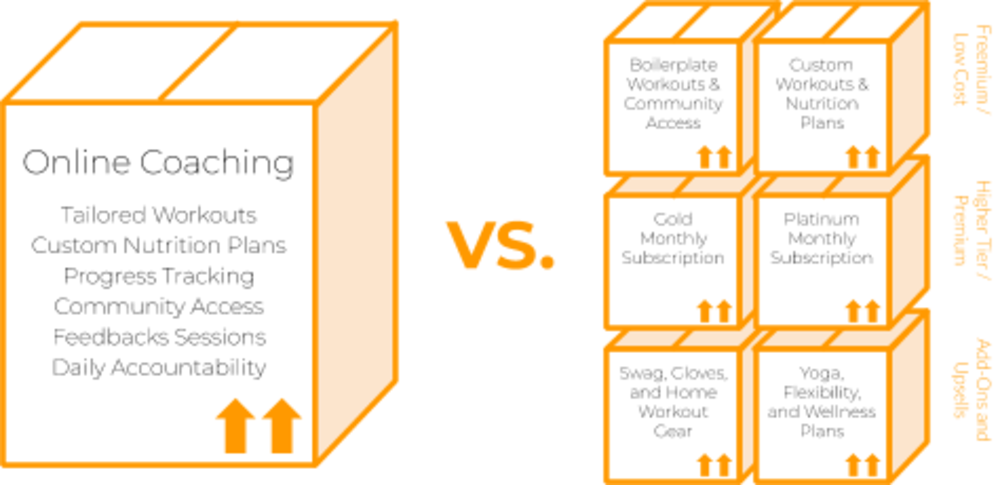Consumers are being forced to reduce spend on everything but the essentials, which is why we have created a series of webinars to help you out during these difficult times. Visit this page to know more about the topics we have discussed with our panelists and learn all the tips experts of the industry gave based on their experiences.
We have also recommended changing your business to a value-first strategy, we discussed how should the pricing strategy change and why you should offer a new free membership package to attract new potential members. But you’re still a business, right? And businesses need money coming in the door to keep the lights on.
So how do you go from offering free packages to keeping the lights on? And what do you include in a free package that it offers values to members but doesn’t require any of your time?
In this article we will discuss how to build your packages in such a way that freemium doesn’t require any time from, you but still offers unique value to clients and encourages them to upgrade their packages.
Which Pricing Strategy Method Works Best?
In explaining these topics we have to understand two new terms: Upselling and Cross-selling. Your ability to build, market and sell upsell and cross-sell packages will determine your success in the new fitness industry.
- Upselling is simply moving a client from one package to another higher cost and higher value one.
- Cross-selling is selling individual services or products that compliment the package that the client is already on.
The reason for this is simple: while most businesses will try to build all-inclusive and low-cost packages because they believe that’s what the market wants you’re going to build a-la-carte package.
These packages will empower your clients to build their own packages that perfectly fit their needs and budget. This, again, allows you to differentiate not on price - but the quality of service. So, read more here about how to price gym memberships by reading further.

1. Freemium Package ($0)
Freemium packages, by nature, are somewhat paradoxical. They need to be something that people would pay for, but with a $0 price tag. Because people must be willing to pay for them, they must deliver a high level of service.
But because they’re at a $0 price tag they mustn’t require any ongoing maintenance. They need to be off-the-shelf but tailored. Both invaluable and free. How is that even possible? With technology.
Technology allows you to operate at scale with low overheads. It allows automation of repetitive tasks and empowers end-users to customize their own experience so that you don’t have to.
It’s only with technology that freemium even becomes possible (which explains why it’s so popular among tech brands.) In this section, we’re going to discuss what your freemium package should look like and why.
The value of a freemium model
Over the last few years, a number of studies have asked fitness consumers what it is that they value from their membership. If you’ve operated a facility for any length of time the results probably won’t surprise you. Fitness consumers value 4 key elements:
- Progress - Memberships aren’t (normally!) free. They’re subscription services that are an investment. And consumers expect a return on that investment in the form of results.
- Relationships - More than open spaces with heavy things dotted around, gyms and studios have become social clubs. At the end of the day, we’re social animals and enjoy engaging with other like-minded individuals. Fitness enthusiasts are no different.
- Touchpoints - These are touchpoints from staff. People like knowing that the brand they’re giving their hard-earned money to actually cares for them. They don’t want to pay some large anonymous brand unless they have to.
- Technology - With over 60% of the fitness market being millennials, it’s no surprise that they expect technology to be in every crevice of their life. This doesn’t mean that they enjoy technology for the sake of it. They enjoy the convenience that technology offers.
As such, your freemium package should deliver on all of these elements:
- Give members the means to make progress and easily track it. It should enable them to interact with other clients who share their goals and are on the same journey.
- Allow you to connect with them to give feedback, motivation, advice, and share your (and your brand’s!) personality.
- Allow gym members to do this all in a convenient manner. The fewer platforms the better. Just like funnels , the more complicated things are the more clients you’ll lose!
And if this doesn’t suit your needs, there are more paid memberships you can customize for your fitness center.
Core Package ($10 - $30)
Essentially, this package is going to be a paid version of the freemium model, leveraging templates and automation to allow you to manage a large number of clients with no time investment. And it’s most likely going to become your most popular one.
Why? Because it’s going to have a whole lot of content that is going to appeal to a wide range of people. It’s also going to take advantage of more strategies to build relationships between clients and between you and your clients.
To create more touchpoints, and at a higher value to encourage freemium clients to upgrade, you will want to create spaces for discussion around more specialized topics such as injury prevention and care, training for specific sports, and so on. The exact topics and themes of these groups will depend on your members - who do you generally attract and what do they enjoy learning and discussing?
To help strengthen the relationships between clients you should begin to include challenges . Build out challenges around what your clients care most about accomplishing and have them working together as part of teams or individually against each other. Make sure that you have leaderboards in place, as what’s a challenge without winners?
And of course, you should have more approaches to achieving goals and seeing progress. Include more workouts (i.e. the upper-intermediate and advanced versions of the previous ones you created) and also include the ability to track nutrition.
These elements themselves will encourage people to upgrade their accounts, but pairing them with the new touchpoint and relationship options will really drive home the value you’re offering.
2. Premium Package ($100 - $300)
The premium package is different from the previous two. While the Freemium and Core packages are built around automation and high scalability, the premium package is built with personalization in mind. This makes it less scalable but justifies a higher price point.
The goal with the premium package is to appeal to those clients who haven’t experienced as large a gap between Desire and Ability to purchase. They still highly value their health and fitness (as all your clients do) and still have the financial means to invest in it.
There’s no secret to this tier. It’s your standard personal training service. You hold consultations with clients, evaluate their lifestyle and habits, build workout plans (and maybe nutrition guidance?), and track their progress.
You also leverage the touchpoints elements, motivating them, holding them accountable, giving suggestions, and ensuring that they’re always in the best possible position to achieve their goals.
3. Add-Ons ($15 - $100)
Add-ons are key to letting your members build truly customizable services that deliver the value that they need and want at a price point that they can afford. It doesn’t isolate potential clients like other packages may, instead it embraces them and their situation.
It looks like this: imagine you have a client on the Core package who really wants to be on the Premium package because they want that level of personalization. But they can’t afford it. It’s $150 a month, which is simply too much.
What if you could offer them personalization without the $150 price tag? What if you offered them a custom workout plan for $50? And a meal plan for $25? They won’t get the weekly check-ins, or accountability, or motivational messages, or regular adjustments to their workout - but they don’t really want or need that stuff anyway.
In this instance, you’re giving your client the value that they want from the premium package but stripping out the unnecessary stuff. And with that, they now have the opportunity to spend more money with you. By having a business model that allows this level of customization you avoid putting yourself in the situation a lot of your competitors will.
They’ll alienate potential customers with “take it or leave it” offerings while you’ll be embracing those very same potential customers and growing your bottom line as a result.




